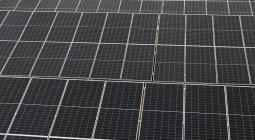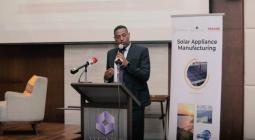Please briefly describe your background: where are you from, what was your education?
I am Samson Tsegaye from Ethiopia. I am married and I have three children.
After I finished high school, I joined the Ethiopian Military Academy and studied there Military Engineering. I served for more than 11 years.
I then studied “Project Management in Renewable Energy Industry” at the Renewables Academy in 2012 and received Diploma. Continuing, I studied “Business Management and Entrepreneurship” at Alison Academy and received Diploma in 2013. I took another course in 2014 on “Grid Connected PV system Design and Installation”. And additionally, I took a course in Germany in 2020 on “Practice Oriented Training on Renewable Technologies” at Wildpoldsried.
Beside the above courses, I took several different short-term trainings on Solar PV technologies.
What inspired you to become involved in decentralized energy supply in Ethiopia?
I saw the PV technology for the first time in 2002 at Intersolar, Freiburg, Germany.
I then decided to bring this amazing solution to my people as Ethiopia is the “Thirteen Months of Sunshine” country. Back on those days, PV technology was used in Ethiopia mainly by Telecom companies and few households.
The PV technology inspired me to get involved in the sector as it could solve most of my people’s problems and life situations.
Over 80% of the Ethiopian population reside in rural areas. Only about 17% of them have access to electricity. Their main lighting solutions are kerosene lamps and firewood. These solutions affect their health a lot and they are also difficult to access.
Most kids in rural Ethiopia suffered a lot. They are responsible for many activities at home. They must fetch water and also firewood from very long distances walking many kms. Not enough time for them to go to school on time. Additionally, they also have to walk long distances to and from school. When they are back home, it is already dark. No chance for them to do their assignements and study in the dark with a smoky kerosene lamp. And they sometimes don’t have enough kerosene at home.
So, most students simply can’t go to school or even if they can, it is not easy for them to be competitive with urban students and school dropout is high in rural areas.
As I mentioned above, Solar PV technology is the best solution to solve these serious issues and I got inspired as it can solve so many problems of my people.
And after installing our solar lighting in rural communities and turning on the lights for the first time: I have never seen so much happiness in people’s eyes in my life. I myself have sometimes helped those in need by donating money or other things. But giving light to people living in darkness is really something special. My eyes always filled with tears.
So, I was almost infected and am now addicted to solar technologies.
What do you consider to be your most personally influential professional experiences when it comes to promoting decentralized solar energy in your country?
The first and very important point is understanding the real need of our community.
Some decide the communities’ needs themselves by expecting that most rural communities are the poorest of the poor. Which is not true when we really understand the community real need. Understanding them leads to finding the right solution for their problem and interest. With such approach it is possible to create trust in the technology and the service provider too.
The second important issue is to prepare proper professionals for proper service delivery and also proper information to the user by training solar PV professionals.
Selecting the right technology and quality is also very important. Sometimes in Ethiopia, size matters. Users want to have bigger size technologies. They also want to show it to their friends, neighbors and others. As to me, instead of affordability, availability in different sizes and cost is most important.
By considering the above important issues, it is possible to promote the technology in a better way in my country.
What does your current job involve?
I got involved in Solar PV technologies in 2002. I then became a country director of Stiftung Solarenergie since 2007. I am still responsible for the foundation’s overall activities.
Currently, we are doing solar PV installations for Hospitals, Health centers and schools. Besides that, we support rural students by providing them solar lanterns to use for light at their home. We also installing Solar Water pumping for Community water supply.
We also are providing trainings on Solar PV Technologies for solar technicians and TVET instructors at our training centers.
Can you tell us about projects you are currently working on?
One of our current projects is providing training for TVET instructors.
Solar PV technology was not in the Ethiopian Education curriculum. We, Stiftung Solarenergie and DGS Germany, prepared the curriculum, financed by ADRA Ethiopia and now the curriculum is approved by the government to provide the Solar PV course in TVET colleges.
We recently trained instructors from different TVET colleges at our training centers to capacitate them on Solar PV technology, Installation and Maintenance. With this training, it will be possible for them to train students at their college on Solar PV technology.
The other project we have is on solar power for Health institutions and sustainability project. Installing solar power for Hospitals and Health centers is essential. Most health centers located in rural areas have no basic infrastructures. Because of the lack of such infrastructures, pregnant mothers have to travel long distances. Many mothers and children died. By installing solar power in such institutions, it will be then possible to save mothers and children’s lives.
Additionally, this project involves providing continuous maintenance support for installed solar systems and providing training for the health workers on how to properly use the system. By doing such activities, it is possible to keep the equipment delivering proper service for longer time.
We also have a project on solar power for rural students and schools. With this project, students receive solar lanterns from us to use at their home for lighting purposes. Their families also are benifiting from the light. It helps them get additional study time to do their assignments.
In your opinion, what are currently the biggest obstacles to making decentralized solar energy more widespread in your country?
Over 80% of our rural communities need such solutions like solar lights. The current kerosene price is very expensive besides its side effects. Firewood is also a scarce source and not easily accessible. Solar solutions are the best solution for these communities and the demand is very high.
Finance is the first main challenge to widespread decentralized solar energy for many players in the solar sector. Not only this, accessing hard currency for importing solar equipment into the country is another big challenge. There is increased shortage of hard currency in the country since the past seven/eight years. This makes the activity more complicated and creates shortage of solar equipment in the country.
The import procedure policy for solar technologies is very complicated. No clear policy at all. Every time it is different. This leads to bad quality products being imported through boarders in contraband ways. Currently, the solar PV market is flooded with very poor and bad quality products. This creates a bad feeling and reputation for the Solar PV technology and kills its good image. Also, the price difference between the quality and durable products and the very poor and cheap products confuses the users.
What support in particular would you like to see to strengthen the local solar economy?
One of the best solutions to strengthen the local solar economy is supporting local manufacturing.
By doing this, it makes it easier for distributors to access the technology in smaller quantities.
Financial and policy support are very important for companies to establish strong infrastructures and to strengthen the local solar economy.
What would you recommend to a young Ethiopian who wants to work in the field of decentralized solar energy in his country? Is there a career perspective for him/her here? And if yes: how should he/she approach it?
The demand by itself invites young professionals to involve in this business. Still the market needs proper professionals to deliver proper service and technology to the community. First of all, they have to create trust between their customer, their service and the technology. This can help them create a job for themselves in this sector.
They must take proper trainings to understand the tehcology properly and to provide proper supply and maintenance services.
Their main challenge will be the working capital to start business. There should be the possibility to access finance from MFIs or banks or by organizing funds and/or grants.
The current trend is that governments allocate some finances to establish small enterprises. Trained technicians can approach this government finance or MFIs for loan. With this approach they also can have access to the users.
Additionally, they also have to work together with big importers as importing small quantities is not easy and cost-effective. With this approach they can be a distributor.
For Ethiopians, the Ethiopian Solar Energy Development Association can assist by connecting them to importers. Most importers lack proper professionals for their distribution channels.






